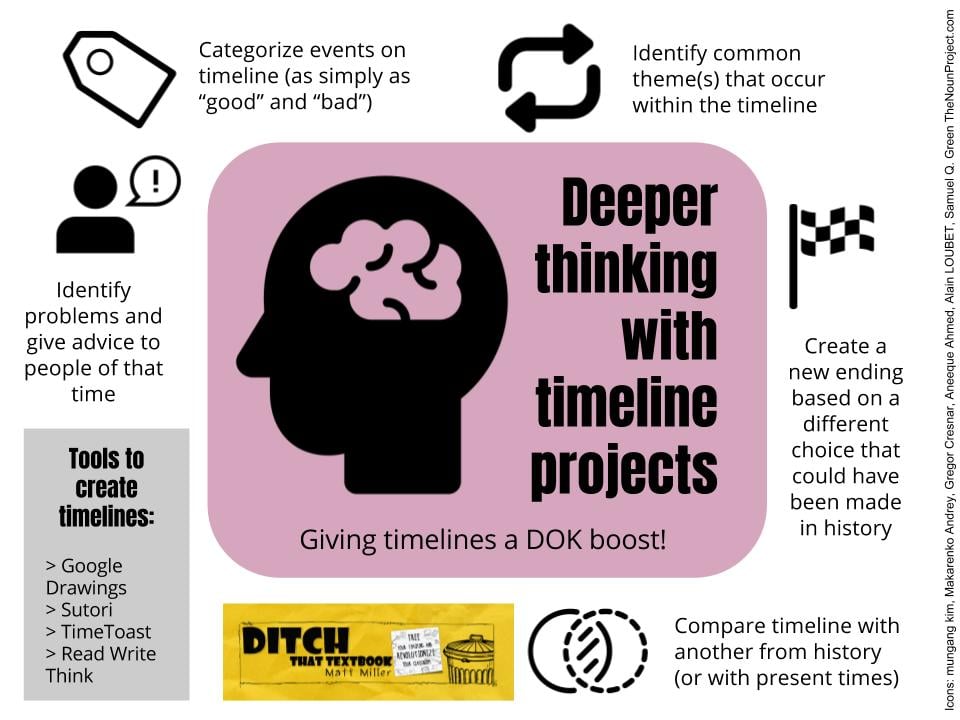

Timeline projects can be one-dimensional with shallow thinking. But they don’t have to be! Here are some ideas to kick up the Depth of Knowledge level. (Graphic by Matt Miller)
It’s easy to get stuck in a rut. As cyclical as education is, it’s almost impossible not to.
We do the same activities year in and year out — even if we’re constantly trying to reinvent our classes. It happens to the best of us.
Twitter is a great way to get unstuck. It also helps others to get unstuck. Kudos to Jane Highley for that.
She recently posted a question that caught my attention:
How can designing a timeline be a rigorous activity?
Higher-order thinking and Webb’s Depth of Knowledge have been top of mind for me. (I spent some time recently with Alice Keeler, my co-author for Ditch That Homework. Spend more than 15 minutes with her and you’ll hear her say “DoK”. And that’s a good thing.)
Timelines. Poster projects. Brochures.
Any traditional activity can be put through the DOK/higher-order thinking process. Take an old, tired activity and put a deeper spin on it.
Here were some suggestions I gave Jane for her students’ timelines:

Deeper thinking with timeline projects. Icons via TheNounProject.com. Created with Google Drawings. See a post here on how to create these infographics yourself. (They’re really easy!)
1. Compare timeline with another from history (or with present times). Compare/contrast kicks the Depth of Knowledge up to DoK level 2: Skills and concepts. Some ways to compare/contrast:
2. Identify problems and give advice to people of that time. Giving advice kicks the DoK up to level 3: Strategic thinking. Some questions to ask/answer:
3. Create a new ending. This also kicks the DoK up to level 3: Strategic thinking. This is like putting a fork in your timeline. There’s the way it happened and the way it could have happened. Ways this could be done:
4. Categorize events. Tagging events on a timeline can help students make sense of them and what the timeline says as a whole. It kicks the DoK up to level 2: Skills and concepts. A deeper explanation of why they’re categorized the way they are takes it up to level 3: Strategic thinking.
Some ways to categorize items on a timeline:
5. Identify common themes. What does the timeline say as a whole? This kicks the DoK up to level 2: Skills and concepts. Explanation and justification of those themes can bring it up to DoK level 3: Strategic thinking.
The themes could be added above or below the timeline. Think of them as a headline or a title. A subheadline or secondary title could be added to give further explanation, like a secondary title better explains a vague title of a book.
Several tools can help you create timelines, like:
For notifications of new Ditch That Textbook content and helpful links:
Interested in having Matt present at your event or school? Contact him by e-mail!
Matt is scheduled to present at the following upcoming events:
[getnoticed-event-table scope=”upcoming” max=”15″ expanding=”false”]
Session expired
Please log in again. The login page will open in a new tab. After logging in you can close it and return to this page.
[…] Click here for more ideas for creating great timeline activities that promote deeper thinking. […]
[…] MORE: Deeper thinking with timeline projects […]
Your site helped me a lot to know several things, thank you very much.
[…] Deeper thinking with timeline projects | Ditch That Textbook […]
Great post Matt! I’d love to do something similar with our Wax Museum project (dress up like person you read biography on and speak 2-3 min) which is currently DOK1 and missing the 4Cs. A typical timeline was done in Tech but this really kicks it up a notch! If your readers have any additional ideas, please share ????
I use categories with our timelines…I love to have students categorize events as social, economic, and political. Then justify their choices to other students or teams. It can make for some interesting conversation. Another ones to have students creat a picture timeline with no words. That one is super fun!
Great post!
BTW, check out this timeline tool: https://timeline.knightlab.com
I haven’t used it with my students yet, but I introduced it to my daughter and she used it for a social studies project and it was pretty awesome! Both her and her teacher really liked it and it helps with digital citizenship as it forces students to cite their sources. Let me know what you think,
Ooh, that’s a good one. Thanks for the suggestion!
In terms of “Create a New Ending” – reverse the order of 2 events on the timeline. Would it make a difference? Why? How would each event, as well as the outcome, be different?
Wow … I never would have thought of that! Great idea!
I have my students find cause and effect relationships with the events on the timeline, We also categorize the events, and then I have the students make a “Top Ten” list, (Our timeline is events leading to statehood for Washington State) where the students pick out the top ten events that led to statehood in their mind, and they have to justify their picks.